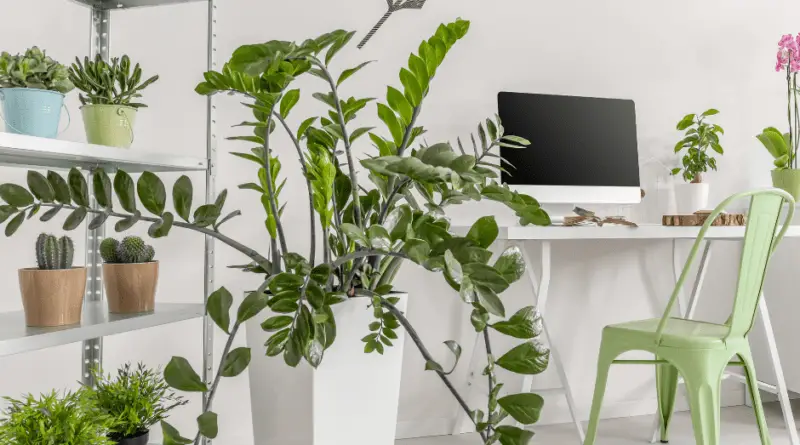Last modified on September 21st, 2023 at 5:18 pm
10 Houseplants That Are Good For Your Health
Eating plants isn’t the only way to reap their benefits. Science has shown that simply keeping houseplants can do miracles for your health. These plants look striking, sculptural, and beautiful. But the best part about indoor plants is they work sensationally for our health and wellbeing. Research has revealed that some indoor plants are highly effective at absorbing and purifying toxins and chemicals in the air.
This means shedding the air from bad chemicals while also producing oxygen, making it much easier for us to breathe. What’s more, studies have also shown that being surrounded by lush green natural vegetation and plants is good for reducing stress, lowering blood pressure, and improving mental health. There are many health gains from growing and keeping plants inside your home. Deco Facts has picked ten houseplants that are good for your health. Click here for the best indoor planter and pots.
Snake Plant/Sansevieria
Sansevieria has different names. It is more commonly known as the snake plant or mother-in-law’s tongue, but don’t let that put you off. Sansevieria is one of the most recommended plants for improving the air quality in the house. The snake plant is one of the finest indoor plants to have. It is a beautiful plant with such an exclusive look.
The study has shown that the snake plant is the most oxygen-producing plant, which is a huge plus. Another famous benefit of the snake plant is that it gives oxygen at night, assisting in easier breathing. This is not just it; the snake plant is also great for purifying the air. It helps absorb toxins like carbon dioxide, formaldehyde, and benzene.
The snake plant is extremely hard and can happily thrive on negligence. Although the plant prefers a lot of bright light, it can withstand small amounts of light for long periods. This plant will thrive in the full sun OR full shade, and even when water is scarce.
Spider Plants
Spider plants are popular houseplants because they are easy to grow and hard to kill. These plants flourish in poorly lit residential areas and can survive even irregular watering. These plants also have a positive influence on air quality. Spider plants remove formaldehyde from the air, which enhances indoor air quality. Spider plants also help eliminate injurious contaminants like benzene from the air. They are known to be one of the easiest houseplants to keep alive because they require very little watering and only indirect sunlight. Sources of formaldehyde in a home include building materials and carpets. You can find benzene in furniture polishes and laundry detergents. Think about adding a spider plant to your home to help purify the air.
Peace Lily/Spathiphyllum
Spathiphyllum, often known as the peace lily, is one of the most beautiful and healthy plants. This beautiful evergreen plant is considered tranquil to care for, even by those who do not have a green thumb. They require very little light or water to stay healthy, which is one of the main reasons they are one of the most popular plants to keep in your home.
Analysis of houseplants by the North American Space Agency found that the peace lily was the most effective at removing volatile organic compounds from the air, including formaldehyde, trichloroethylene, and benzene. Remember that Spathiphyllum should never be exposed to direct sunlight, as the sun’s rays can cause leaf burns. While they are great to have inside your home, they also work great as a ground cover around your home.
Chrysanthemum Morifolium
It is sometimes known as the Florists’ Daisy or Hardy Garden Mum; this plant is another popular perennial that people love to have in their homes. Different from the peace lily, this indoor plant likes direct sunlight and an intermediate amount of water. With proper care and the right type of soil, Chrysanthemum morifolium will begin to produce many beautiful, multi-colored flowers. These flowers not only help enhance the beauty of the house, but they also help purify the air of many chemicals common in homes.
Rubber Tree
The rubber plant is a lovely add-on to your home. It has very nice-looking greenery, which makes it a great pivotal point in your home. Its large leaves act as a magnet for toxins like bacteria and mold spores, which essentially clean your home for you. You will want to keep a rubber plant’s soil moist but not very wet. Also, it grows well with lots of natural light. If you’re patient, this is a great plant to buy young as it will adapt well to its surroundings right off the bat.
Aloe Vera
Aloe Vera is one of the best. It is a beautiful juicy plant which likes the light very much. It’s great at absorbing moisture, making it the perfect plant for your bathroom. It is very easy to keep alive. This plant releases oxygen and absorbs carbon dioxide at night, making it an excellent air purifier. Aloe is also great for burns and skin irritation. You can use it as a hair mask, face moisturizer, a shaving gel.
Boston Fern
With its mass of lush green foliage, Boston fern is considered one of the best houseplants for cleaning the air. This evergreen plant not only helps remove dangerous toxins from home but also improves moisture by helping restore humidity in the air naturally. Because of these air-purifying properties, Boston fern is believed to offer real health benefits for people with dry skin, irritable noses, or throats. They look super stylish when hung around the house on hangers.
English Ivy
English ivy could be one of the most gratifying plants to grow inside your home. This evergreen vine is extremely popular in landscaping. You may have seen it used as a ground cover in areas where grass does not grow or perhaps climbing up the side of a wall or the trunk of a tree. Due to its carefree nature, it has gained some fame.
It is a beautiful, bright, fast-growing houseplant that looks great in a bedroom or living room. As a bonus, English ivy is pretty much a medical wonder. This herb is also used to treat a variety of respiratory ailments such as asthma and bronchitis. It is known for its many healing properties, including anti-inflammatory, antioxidant, antiviral, and anti-arthritic properties.
Lady Palm Tree
Lady Palm or Broadleaf Palm is another plant that would be beneficial to have inside of the home. Because this type of palm is greatly patient to the low light conditions, it is easy to grow indoors as an indoor plant. This palm has a slow growth rate, growing less than a foot in height per year. With a max height of around six and a half feet, it is the seamless palm tree to have in a dark corner of your home. They can tolerate low light levels, large amounts of water, and a wide range of temperatures. Although this houseplant prefers to live in moist soil, it must have adequate drainage to prevent root rot.
Devil’s Ivy/ Golden Pothos
Often referred to as Devil’s Ivy or Golden Pothos, this popular houseplant is native to the Solomon Islands, but it is found all over the world. It is evergreen vines and small heart-shaped green leaves streaked with yellowish-white hues; this houseplant is typically sold in decorative hanging baskets. It is best to keep this plan near a window, out of direct sunlight. The soil should be cloudy with high humidity. It is one of the most popular houseplants, not only because it looks great in your home, but also because it is extremely easy to maintain.



